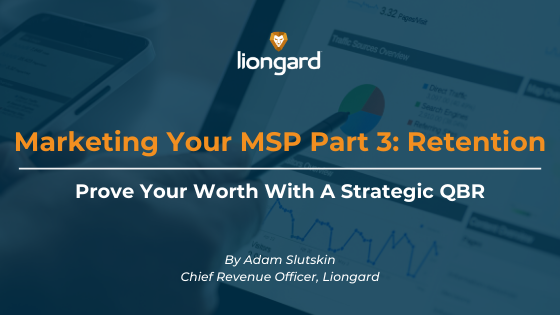
USE LIONGARD TO ELEVATE YOUR QBRS AND MARKET YOUR MSP TO EXISTING CUSTOMERS
In Part 1 and Part 2 of our Marketing Your MSP series, we covered customer acquisition and development, respectively. Once you’ve got a customer on board and you’ve gotten into a service rhythm, don’t fall into the habit of letting relationship development slide. Due to the mostly “unseen” nature of their services, it is highly recommended for MSPs to be diligent about demonstrating their worth to customers. Quarterly business reviews (QBRs), including metrics available through Liongard, give you the chance to further market your MSP and cement valuable long-term partnerships.
Best Practices for Successful QBRs
Ensure your QBR is not just another meeting on your customers’ calendars by following these best practices.
- Include all stakeholders. It’s imperative to have the right people in attendance. First and foremost, you want the person who signs your checks to be there, whether it’s the owner or the CFO, so you can directly answer that familiar question, “What are we paying you for?” Also make sure their CEO is present, as well as your point of contact. From your end, the account manager provides the reports and agenda, and usually runs the meetng. You may want to include other members of your team as well, if they can provide additional value to the meeting and relationship.
- Make it convenient. Since you’re trying to corral several people with busy schedules together for this important meeting, make it as easy as possible to attend. Choose an early time when they’ll likely have fewer meetings scheduled, and provide breakfast (you can’t go wrong with coffee and bagels) which can create a more relaxed atmosphere and also gives meeting attendees one less thing to prepare in the morning.
- Be thorough. You may only get in front of these stakeholders every quarter—or less—so use your time wisely to prove your value as a strategic partner. Include the following points in your QBR:
- Service Ticket Review. How do your opened and closed ticket numbers compare? Highlight your efficiencies or suggest other service structures if needed.
- Service Level Agreement (SLA) Review. Look closely at the standards you’ve agreed on with your customer to demonstrate your performance and address any areas that need improvement.
- Technical Review. This is the most important part of the QBR, where you can spotlight the value you’ve provided in a number of areas, including:
- Endpoint Management. Now’s the time to draw attention to all of the typically invisible work you’ve been doing to deploy, update and troublshoot endpoint devices. Discuss patch management, security and warranty expirations.
- Infrastructure Management. Since this conversation covers important yet technical areas like network uptime data, server backups, data trends and domain admin audits, make sure to take your time and explain in easy-to-understand terms why each is important and how you’re delivering on (and exceeding) your promises in each area.
- Network Security Defense. Discuss threats you’ve detected and steps you’ve taken to proactively address them.
- Strategic Planning. Together, look ahead at your customer’s roadmap and discuss specific ways your MSP can help them meet challenges head-on and reach their goals. Now is the time to discuss service additions or upgrades as well as demonstrate your expertise in the MSP space and solidify your commitment to the long-term health of their business.
Maximizing Your Value with Liongard
At the end of the day, your customers want to know that there are good reasons they’re paying you well for your services: What value have you added? What threats have you detected and thwarted? How much stress have you saved us? How have you helped save us money? With automated documentation, actionable alerts and robust reporting capabilities, Liongard gives you the power to effortlessly have these conversations so you can maintain and retain accounts for the long-run.
With fresh, living, breathing data always at your fingertips through Liongard, you’ve unlocked the answers to all the aforementioned questions (and more).
- Unified visibility across the stack means improved average time to resolution (ATR)—a 62.5% improvement in the case of TeamLogic IT-Memphis.
- Historical timelines let you pinpoint critical changes and even detect third-party errors, which helped Doberman Technologies save a customer relationship and $13,000 in monthly recurring revenue (MRR).
- Actionable Alerts give you the control to set unique parameters and have tickets automatically sent to your PSA. Track privileged users in Active Directory, domain expirations, Duo users in bypass mode, admin accounts in Office 365 without MFA enabled and more, so you can move from a reactive to a proactive state. You can also set alerts for things like unused or duplicate Office 365 licenses, an easy way to help your customers save money and demonstrate your value.
- Reporting and metrics available in Liongard let you monitor your customers, track trends, measure performance and improve how you market your MSP at quarterly meetings. Before Liongard, one of our customer reports that they used QBRs to check documentation; now, they utilize that time to conduct expert, forward-looking reviews.
To better market your MSP for long-term customer retention, start by upping your QBR game with this handy MSP Quarterly Business Review Template from BrightGauge and populate it with the valuable metrics you receive from Liongard.
In case you missed it, read Part 1 Marketing Your MSP: Customer Acquisition and Part 2 Marketing Your MSP: Customer Development.